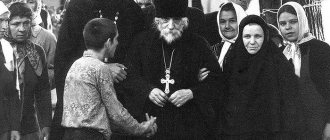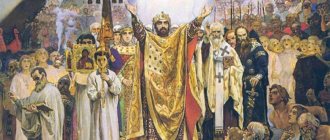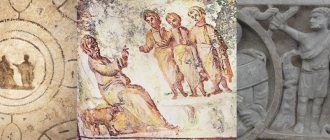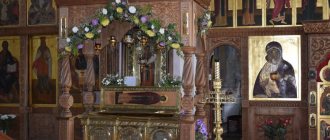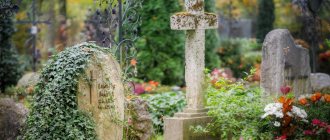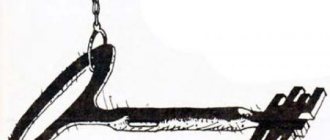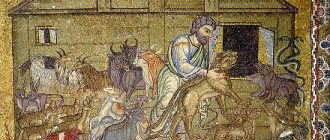Orthodox Life
Myrrh, together with incense, is mentioned among the gifts of the Magi and is found more than once on the pages of Holy Scripture, however, unlike incense, it has a slightly different symbolic meaning.
Before we talk about the symbolism of myrrh, let's talk about this fragrant ingredient. Even in the era of antiquity, myrrh had another, more common name - myrrh (not to be confused with myrrh - a multi-component church incense). And, in fact, under this name it is better known in sources up to our time, and therefore we will operate with this name.
The word "myrrh" comes from the common Semitic root mrr, meaning "bitter." In Aramaic and Arabic this word sounds like murr, in Hebrew it sounds like mor. It entered the ancient Greek language in two dialectical forms: μύρρα and σμύρνα (“myrrh” and “myrrh” in Byzantine pronunciation) and in Latin: myrrha.
It is also interesting to note that in ancient Greek the related word μῠρον (muron) became a general term for perfumes and incense in general.
Commiphora myrrha
Myrrh, like frankincense, is a resin. In a sense, myrrh is a “relative” of frankincense, since it is also extracted from trees of the burzer family, but, unlike frankincense, not from the genus Boswellia, but from the genus Commiphora. Actually, this plant is called: myrrh commiphora (lat. Commiphora myrrha).
This is a small, about 4 meters, tree with thorns and bright red flowers. Grows in Arabia (Oman, Yeomen), on adjacent islands (for example, Socotra), in the arid regions of Northeast Africa (Djibouti, Ethiopia, Somalia, Kenya).
Cuts are made in the bark of the tree, from which the sap begins to slowly flow, congealing in the form of “tears.” Drops of myrrh juice are initially pale yellow in color, becoming reddish-brown as they harden. The resin is collected two weeks after the cut. The collection process is carried out twice a year - in spring and autumn.
As you can see, the growing area of Commiphora myrrha and the method of extracting its fragrant resin largely coincide with the growing area and method of processing incense wood (especially since these are related plants, as we have already said), but the fundamental difference between myrrh is the special bitterness and melancholy of its aroma , which have long been associated with sadness in ancient cultures.
Thus, one of the ancient Greek myths tells about the daughter of the Cypriot king - Myrrha-Smyrna. For her sins, she was turned by the gods into an incense tree, the resin of which is actually the tears of Myrrh.
Indeed, the woody, warm smell of myrrh resin, unlike incense, is more bitter (let us remember the origin of the word itself: myrrh = bitter), and myrrh also tastes bitter.
Since ancient times, myrrh was used as a smoking composition for incense in religious rituals and in ancient medicine as an antiseptic. But it acquired special significance in funeral rituals as one of the substances, according to ancient ideas, that prevents decomposition.
Myrrh was used in large quantities when embalming the bodies of the dead in ancient Egypt. This, in particular, is evidenced by Herodotus, who describes in detail the process of embalming and mentions that embalmers fill the body of the deceased with “pure ground myrrh, casia and other incense (except incense)” [1]. These details indicate the special funerary character of myrrh, as opposed to frankincense, accepted in Egypt.
In the Bible, myrrh is mentioned in the Book of Exodus among other substances, from which the Lord ordered Moses to compose the sacred anointing oil (we will talk about this composition separately in one of the following essays).
Adoration of the Magi. Mosaic. Byzantium. XI century. Greece. Athens, Daphne Monastery
Also, myrrh (myrrh) was one of the gifts of the Magi to the Infant Christ (Matthew 2:11), and if gold, according to a number of interpretations, meant a gift to the king, incense - to the high priest, then myrrh was intended for the one preparing for burial. It is obvious that ancient Judea adopted from Egypt the understanding of myrrh as a funeral incense.
Further in Scripture, myrrh (myrrh) is mentioned precisely in connection with the death on the cross and burial of the Savior.
According to the Gospel of Mark, before the crucifixion, the Lord was offered intoxicating wine with myrrh, which, according to some interpreters, was supposed to dull the suffering of the executed man at least a little: “And they brought Him to the place of Golgotha, which means: Place of Execution. And they gave Him wine and myrrh to drink; but He did not accept” (Mark 15:22–23).
And finally, myrrh was used for the burial shrouds of the Lord: “After this, Joseph of Arimathea, a disciple of Jesus, but in secret, out of fear from the Jews, asked Pilate to remove the body of Jesus; and Pilate allowed it. He went and took down the body of Jesus. Nicodemus, who had previously come to Jesus at night, also came and brought a composition of myrrh and aloes, about a hundred liters. So they took the body of Jesus and wrapped it in swaddling clothes with spices, as the Jews are wont to bury” (John 19:38–40).
Position in the coffin. Shroud. 1599 Greece. Athens. Benaki Museum
In Christian times, myrrh began to be used as one of the many ingredients for the composition of liturgical incense (certain types of incense, myrrh, etc.).
Along with its ecclesiastical use, myrrh remained a secular incense, although not as widespread. In modern perfumery, myrrh has been widely used relatively recently. One of the first perfumes with a dominant note of myrrh was La Myrrhe from Serge Lutens in 1995.
Other highlights include Annick Goutal's Myrrhe Ardente ("flaming myrrh") from 2007 and Giorgio Armani's Myrrhe Impériale from 2013. These solemn, serious works are not suitable for everyone, but they will at least allow you to feel the austere and complex aroma.
Dmitry Marchenko
Note:
1. Quoted from: Herodotus. Story. Translation and notes by G. A. Stratanovsky. Under the general editorship of S. L. Utchenko. M., 1972.
See also: Biblical scents. Incense
FRAGRANCES
FRAGRANCES,
or
fragrant SUBSTANCES
(Exodus 30:23, Song 4:10), the use of which was varied, such as
spikenard,
myrrh , fragrant cinnamon, aloe, casia
, etc. For the most part, aromatic substances were made up of a mixture of different fragrant essences: something like fragrant powder for smoking, then a kind of ointment for anointing the body, etc. (Prov. 7:17, Luke 23:56). Some of the aromatic substances were native to Palestine, others were brought to Judea from southern Arabia and India. The aromas mentioned in the Gospel of Mark (14:3) simply mean the fragrant ointment used to pour on the heads and anoint the feet of dear guests (Luke 7:37,38). Among the aromatic substances of biblical times there are many which even today constitute the subject of considerable trade between Europe and India. The Jews used especially a lot of incense when burying the dead; Jewish women wore bottles of perfume on their belts and anointed their bodies with them (Esther 2:12).
Smyrna massacre
Until the beginning of the 20th century. Smyrna was a multinational, but predominantly Christian city, in which 107 thousand Greeks, 12 thousand Armenians, 23 thousand Jews, 52 thousand Muslims and subjects of various European states lived. The territory was divided into an upper city, where Christians lived, and a lower city, where Muslims lived. Its center was considered to be an embankment lined with rich houses in the European architectural style.
After the defeat of the Ottoman Empire in World War I and the conclusion of a peace treaty in 1920, it was decided that Smyrna was a Greek city. However, Turkey refused to recognize this fact, as a result of which on September 9, 1922, Turkish troops under the leadership of Mustafa Kemal entered the city and carried out robberies and murders of the Christian population, which at that time consisted mainly of Greeks and Armenians. About 200 thousand inhabitants died.
On September 13, a huge fire was started that destroyed the part of the city where Christians lived. The people who survived the pogroms (about 400 thousand refugees) were taken out by American and Japanese ships and received help from the Red Cross.
After all the events, Turkey proclaimed the creation of a republic, and Smyrna was renamed the city of Izmir, which became almost completely Muslim.
Sights of Izmir
The modern city of Izmir is the third largest metropolis in Turkey by population (about 3 million), second only to Istanbul and Ankara. In addition to the ancient Agora described above, you can find other attractions here that will interest tourists:
- The Kadifekale fortress (4th century BC), located on the highest peak within the city, was built under the leadership of General Lysimashos, successor of Alexander the Great. Roman and Byzantine bas-reliefs have been preserved on its walls.
- Kemeralti Bazaar (XVIII century), which presents small alleys and squares, shopping centers and workshops. Here you can see and buy a lot of souvenirs and everything else.
- The Kyzylsullu aqueduct, built in Roman times (2nd century) to deliver water from sources to the city.
- The historic Asancer elevator, built in 1907 by engineers from France.
Tourists who come to Smyrna will enjoy the vibrant eastern port-metropolis with developed infrastructure, industry and many ancient monuments, traces of the turbulent history of this ancient city.
±MIRNA
SMYRNA
(Matthew 2:11) is a fragrant substance extracted from the thorny tree (Cistus ereticus), which fluffs up 8 and 9 feet in height, and is chiefly exported from Arabia to the East Indies.
Since ancient times, myrrh
has been a significant item of trade and was part of the St. the Old Testament world (Exodus 30:23), as well as a composition for the fragrant anointing of those who died. It was also one of those valuable gifts that were usually presented to kings and nobles as a sign of special respect in ancient times in the East (Matthew 2:11).
±MIRNA
SMYRNA
(2:8) - a famous Ionian city and one of the most beautiful in the Levant;
located at a distance of 320 stadia from Ephesus and at the same distance from the seashore, at the mouth of the river. Meles on the western coast of Asia Minor. The ancients considered it the crown of Ionia, the jewel of Asia, abundant in its wealth and outstanding in its fine arts. The city was hit at least six times by major or minor earthquakes, lost 60,000 inhabitants to the plague in 1814, and was hit hard by cholera in 1831. The Word of God was sown here back in apostolic times. The church was planted here by St. John the Theologian. The first bishop here was St. Polycarp, disciple of John the Theologian. Currently, Smyrna is considered one of the most prosperous trading cities of the Ottoman Empire. However, its streets, with a population of 150 thousand people, are narrow and dirty. The houses are mostly wooden, without stoves and on one floor. In modern Smyrna, few remains of the ancient city have been preserved, such as the remains of the amphitheater in which the apostle suffered. Polycarp and in it the vaults of those lairs in which animals were kept, etc. Smyrna is currently called Ismir
and has 4 miles in circumference. The harbor of Smyrna is very spacious and provides an excellent place for anchoring ships.
KASIA
KASIA
Ps 44:9;
- the thinnest and most fragrant bark that envelops the woody branches of the brown tree (Cinnamomum Cassia) of the laurel genus. All Your garments are like
myrrh and scarlet and casia,
exclaims the psalmist. It should be noted that the clothes of kings and princes were often anointed with precious incense, which is why, without a doubt, here the psalmist is referring to the fragrant essence, or oil, extracted from the bark of this tree and which perfumed the clothes of the King, the most beautiful of all the sons of men. The tree grows not only in India, but also in Arabia, and was once a very significant item of import to the city of Tire (Eze 27:19). Dan and Javan
are described in the above quotation as traders who brought cassia and incense canes to the trading markets of Tyre. Job 42:14 is the name of Job's second daughter, born after his difficult trials.
